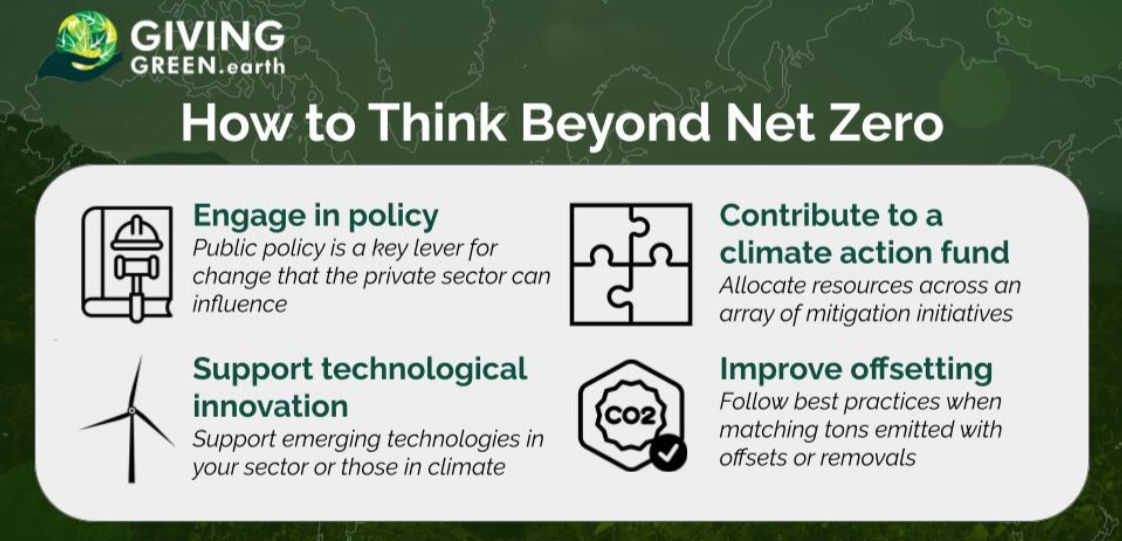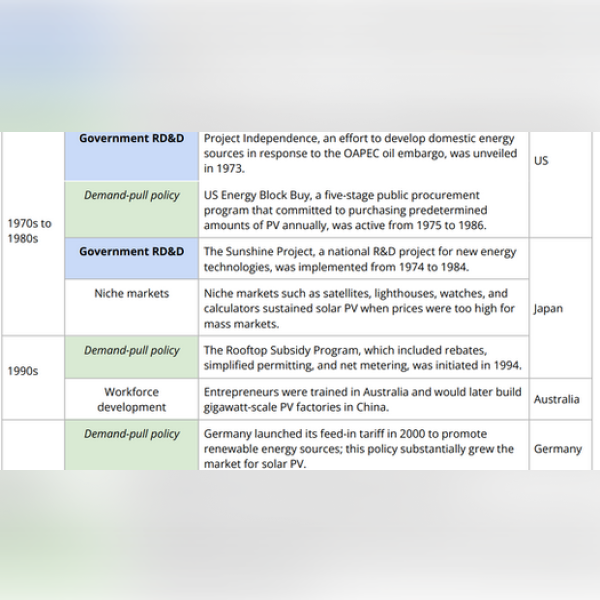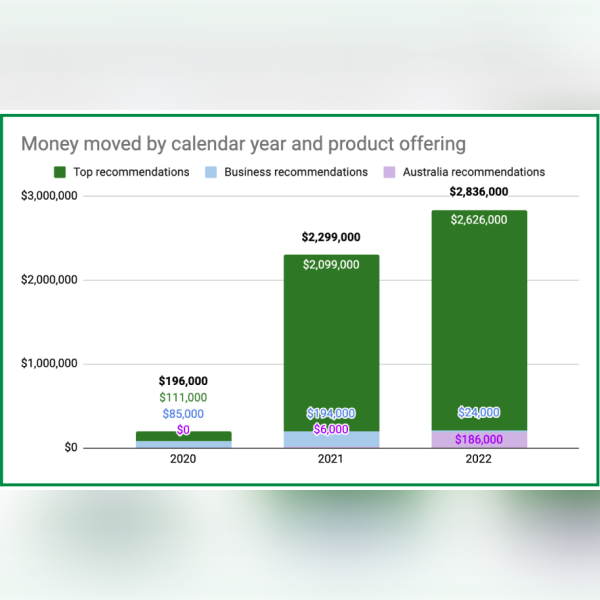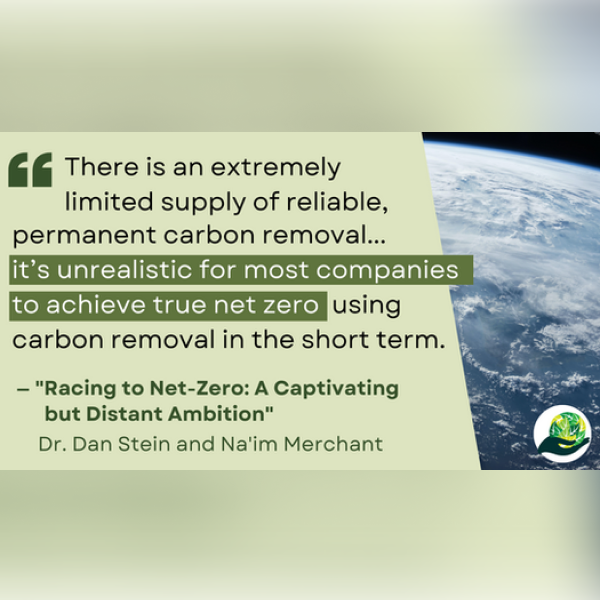Four blueprints to maximizing business climate impact beyond net zero
Amid the growing chorus for more sustainable business practices, intentions are now standing in the glare of scrutiny.
More than one third of the world’s largest companies have now committed to achieving net zero, according to Accenture. Yet, as these climate declarations gain momentum, a litmus test of good faith, viability, and adherence to rigorous standards is becoming increasingly common.
We started Giving Green three years ago to provide evidence-based climate giving recommendations for individuals and foundations. Along the way, we have heard from many businesses that are long on the desire to make a positive impact on the planet, but short on practical and effective ways to reduce emissions.
The problem? It is our impression that net-zero approaches are generally out of reach for most businesses at present.
The challenges are twofold.
Why some business climate strategies fall short
First, our research found that many businesses, especially small and medium enterprises, find it difficult to reduce all or even much of their emissions at present. This is due to systemic issues such as reliance on the grid and complex supply chain factors.
Take the example of a small digital startup for which most emissions come from cloud computing and occasional employee travel. Aside from reducing travel, direct emissions reductions would be difficult without broader systemic change in the power and transportation sectors.
This emissions-reduction ceiling results in businesses looking to carbon offsets to balance out their footprint. As reported in recent media investigations over and over again, the efficacy of many offset projects is highly uncertain. Giving Green’s assessment of the voluntary carbon market also shows that it is extremely rare for a marketed credit to truly represent its advertised amount of emissions avoidance or removal.
How to maximize the impact of corporate climate action

Instead of assuming that conventional frameworks are optimal, we encourage businesses to explore the following question: given a set of available resources, how can a business maximize its climate impact?
This fresh perspective allows for nuance, innovation, and the acknowledgment that, in certain situations, carbon accounting on paper may limit the real-world impact of a company’s climate action. While each company will inevitably need to confront constraints in its climate strategy, it can also weave in its unique set of resources and opportunities.
To highlight the exciting potential of this “beyond net zero” approach, we convened a panel of four forward-looking companies that have gone beyond their own value chain to maximize their climate impact.
4 examples of higher-impact business climate strategies
Microsoft
The genesis of Microsoft's beyond-net-zero climate strategy dates back to 2012 when it became carbon neutral. The same year, the firm launched a first-of-a-kind carbon fee, an internal tax to set aside certain amounts of money for climate mitigation.
The tech giant started off by purchasing renewable energy credits, which included offset avoidance credits, but it quickly realized that offsetting or avoiding was not enough.
“We think those who can do more should,” said Annie Guo, senior program manager of carbon removal at Microsoft, during the webinar.
Similar to Giving Green’s own motivating question, Guo said Microsoft asked itself, “If Microsoft were to set aside some resources, what form would that take and what should we target?”
Part of its pathway is to reduce over half of its emissions and remove the rest, said Guo, adding that the firm’s removal portfolio includes both nature-based and engineered solutions for balance. It also seeks to create markets around medium-to-high-durability solutions.
Additionally, one of Giving Green’s recommendations for businesses is to contribute to or start a climate action fund, such as the Giving Green Fund, to allocate resources across an array of climate mitigation initiatives. Microsoft did exactly that. Its Climate Innovation Fund acts as the venture capital arm of the firm’s sustainability team, investing in a portfolio of decarbonization projects.
Frontier

Another of Giving Green’s recommendations for businesses is to support technological innovation. While net-zero goals are impossible today, we believe supporting technologies that make net zero possible in the future is among the most effective ways to contribute directly to robust climate action.
We encourage companies to support emerging climate technologies in sectors relevant to their own operations and/or to promote climate innovation more broadly. As an example, some companies are contributing to the development and scaling of carbon removal technologies.
To achieve climate goals, carbon removal will be needed in addition to rapid emissions reductions, said Zeke Hausfather, a climate scientist. This is to account for residual emissions from hard-to-abate sectors, as well as global temperature overshoot.
Hausfather highlighted the importance of permanence in carbon removal. He pointed out that low-cost carbon offsets or temporary removals used by companies to achieve net-zero claims rarely fully neutralize the emissions of fossil fuels.
“It’s causing a bit of a realization that we need to not just maximize tons on paper, but we need to maximize the actual real world impact of the dollars we spend on climate,” said Hausfather of recent investigations into “phantom carbon offsets”.
Hausfather now leads climate research at Frontier, an advance market commitment (AMC) intended to support and accelerate the development and deployment of carbon removal technologies. Created by Stripe and founding firms like Alphabet, Shopify, Meta, and McKinsey & Company, the scheme now boasts Autodesk, JP Morgan Chase & Co., H&M Group and Workaday among its partners.
Giving Green’s evaluation of Frontier’s advance market commitment model found that it provides an accessible, anticipatory investment toward enabling future net-zero pledges by supporting the growth and development of a carbon removal market. It is one of Giving Green’s catalytic carbon removal investment recommendations for businesses.

In 2007, Google became carbon neutral, initially through the purchase of high-quality carbon offsets, then through direct purchase of renewable energy via power purchase agreements. Since 2017, the firm has matched 100% of its annual electricity use with renewable energy purchases.
“When we achieved our 100% annual matching goal, we saw it as an important milestone. But we recognized that 100% annual volumetric matching is not the same as using carbon-free electricity everywhere and at all times,” said Devon Swezey with Google’s global energy markets and policy team.
A study by Princeton’s Zero Lab confirms this, concluding that 24/7 carbon-free energy procurement has a higher impact on emissions reduction and power sector transformation than the more common approach of offsetting fossil energy consumption through renewable energy purchases. Climate experts are calling for companies to move from annual matching to matching more of their demand on an hourly basis, which will reduce grid electricity emissions, lead to faster retirement of fossil fuels, and accelerate the commercialization of advanced clean technologies.
Google is pursuing this goal through three tracks. First, the firm is set to buy more and different types of clean energy. Secondly, it seeks to use its investment and purchasing power to commercialize advanced technologies such as geothermal. Thirdly, at the ecosystem level, it aims to enable more consumers to purchase 24/7 carbon-free energy, as well as advocate for policies that support grid decarbonization.
Mapbox

With 690 employees, Mapbox, a provider of custom online maps, was the smallest company among our panel. Its climate strategy provides a unique case study for how small-to-medium enterprises can also influence systemic change through corporate climate action.
“Due to size and the nature of our business, we do have a relatively small corporate carbon footprint, but that doesn't mean we deprioritize our climate commitments,” said Marena Smith, manager of Mapbox’s social impact team. “In fact we’ve used that as motivation to find ways to go further with our climate commitments.”
Giving Green encourages companies to engage in policy, as we believe that the private sector stands to benefit from moving beyond obstruction or inaction toward proactively advocating for robust climate policy. For companies that do not have a direct policy advocacy arm, an indirect but arguably more accessible way is to donate to highly effective organizations working on climate policy advocacy. Building on Giving Green’s recommendations, Mapbox has donated to Clean Air Task Force, which has an impressive track record of influencing large-scale policies and agreements such as the Inflation Reduction Act and Global Methane Pledge.
When it comes to carbon credits, Mapbox’s purchases were from high-quality offset projects such as refrigerant destruction through Tradewater. These purchases were then supplemented by investment in durable carbon removal.
In addition to dedicated climate investment, Mapbox has evolved to leverage its products and customers to further scale its impact. For example, as a mapping and navigation platform company, Mapbox works with logistics and delivery companies to enhance efficient fleet usage, reducing customers’ emissions through the use of Mapbox technology.
“We are leaning into how our customer base and our products can have an outsized impact on emissions, far beyond what our corporate carbon footprint would be,” said Smith.
An actionable guide to effective corporate climate action
A growing number of companies like the ones featured in our panel are going beyond net zero: leveraging their resources innovatively to more deeply influence climate progress. Your company can be one of them.
Giving Green has a comprehensive guide for businesses to design effective business climate strategy and maximize the impact of corporate climate action. Our white paper proposes four evidence-backed, actionable climate strategies, followed by concrete recommendations on how companies can go beyond their own carbon footprint to support policy change, technological innovation, carbon removal, and more.
We offer free 1:1 consultations to businesses large and small. Say hello here.
Support Our Work
Giving Green Fund
One fund. Global impact. One hundred percent of your gift supports a portfolio of high-impact climate organizations, vetted by our research.
Best for:
Donors who want the simplest way to impact multiple climate solutions.
Top Climate Nonprofits
Meet the organizations on Giving Green’s list of high-impact nonprofits working to decarbonize our future, identified through our rigorous research.
Best for:
Donors who want to give directly and independently.
Support Our Work
We thoroughly research climate initiatives so you can give with confidence. For every $1 we receive, our work unlocks another $21 for effective climate solutions.
Best for:
Donors who want to amplify their impact through research.














.png)




.png)










.png)




.png)










.png)








.png)







.png)


.png)






